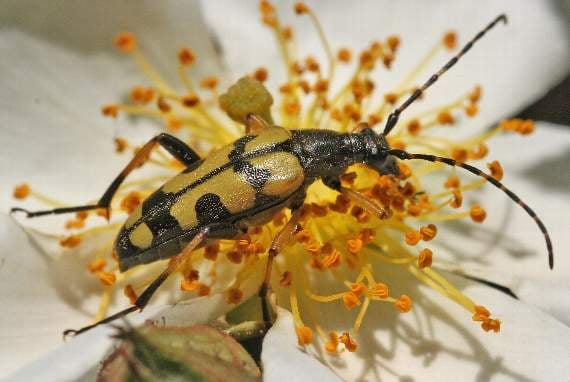In this week’s Nature Watch, photographer Ray Roberts takes a slow stroll, looking under leaves and through the hedgerows to see what he can spot - and finds some marvels of nature while weeding in his garden....
I went over to nearby Blunts for a walk around the country lanes and took my time looking on the underside of large leaves to see if there were any butterfly eggs that are laid from May onwards. The female spends some time in finding the right plant for her caterpillars to feed on and lays numerous eggs. The ones I found were on a nettle leaf and I think they were those of a small tortoiseshell.
When I am out walking, something I do every day, I move at about one mile per hour as I am constantly looking into the hedgerow to see what I can find and spotted a longhorn beetle – Strangalia maculata - feeding on a flower head. This longish black beetle with yellow markings can fly but it is usually reluctant to do so, giving the observer plenty of time to take photographs. They live in rotting tree trunks and are quite common throughout the countryside.
I saw something moving beneath the vegetation and was pleased to see a small wood mouse or long tailed mouse working its way across the hedge obviously searching for any seeds that were there. This is the most common mouse to be seen in woods, hedgerows and old gardens, although it may come into the house during the winter months.
Hogweed – Heracleum sphondylium - is an umbelliferae plant that is blooming on roadside banks with wide white flowers that are tinged with red making a pleasing bloom to look at. Their hollow stalks can reach a couple of metres in height and when I was a boy, we would cut lengths of the stalk, about thirty centimetres long, and use them as pea shooters. Oddly enough the fact that we all had blisters on our lips, the sap being a skin irritant, the next day did not deter us from the same practice the following year!
I saw lots of yarrow – Achillea millefolium – on the hedge near the hamlet of Blunts. These blooms are small and white with pink centres and is one of our most persistent roadside plants and its name, millefolium, means ‘of a thousand leaves’ referring to the yarrow’s numerous feathery leaves. There was also some betony – Stachys officinalis – in bloom, providing a contrast with their reddish/purple flowers.
During the afternoon I spent a couple of hours weeding in the garden and was surprised to see what I think was a wolf spider on the wall carrying a large sac of eggs. Apparently, the female spiders carry their unborn young around in a silken sac so she can literally keep her eye on them instead of just leaving the eggs where they are laid.
Whilst on my knees pulling out docks, I had three things to hand; a long-handled trowel, a small rake and of course my trusty Canon camera, so when a green lacewing landed on a flower stalk, I immediately took its photograph. Lacewing, with their delicate transparent wings are a familiar sight in gardens where they eat small insects and like moths, are attracted to lighted windows during the hours of darkness.




